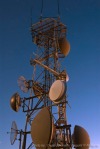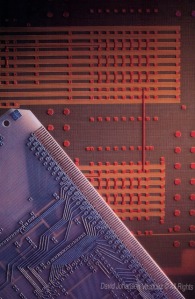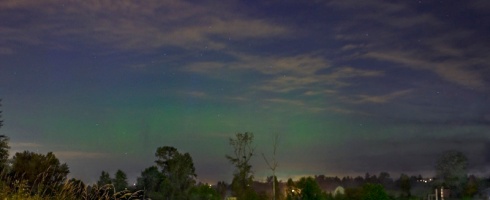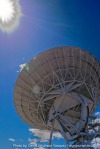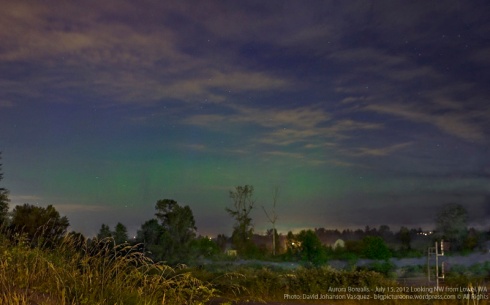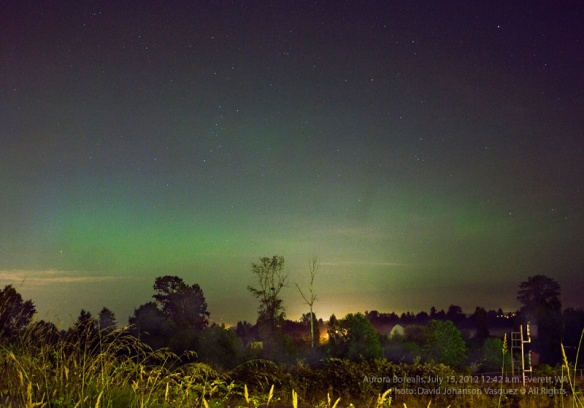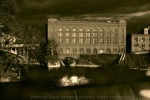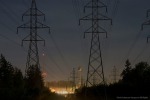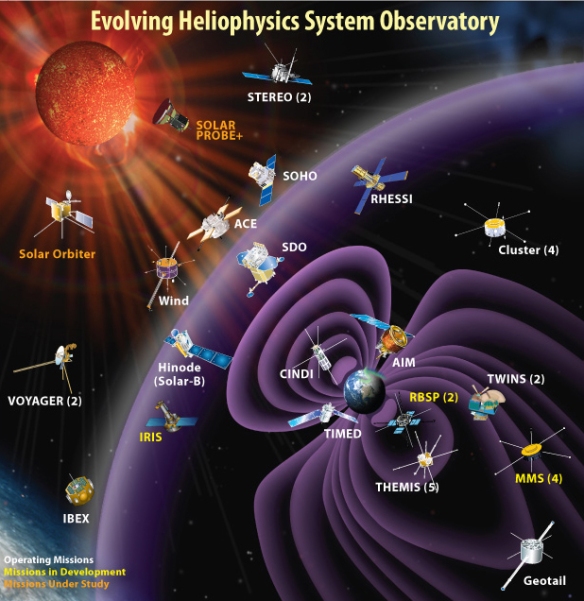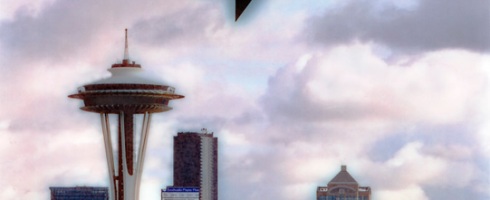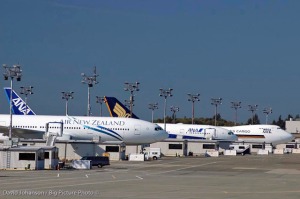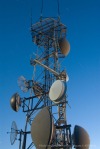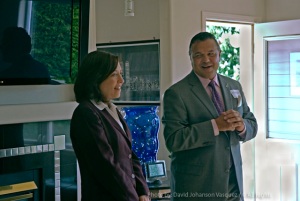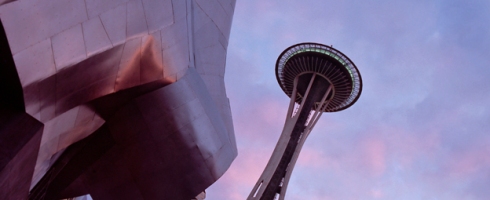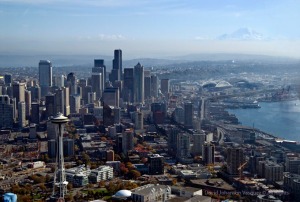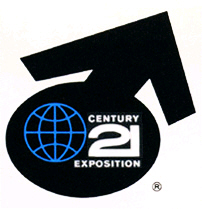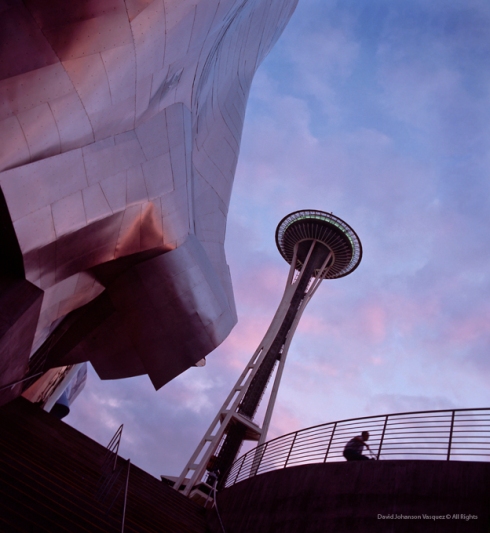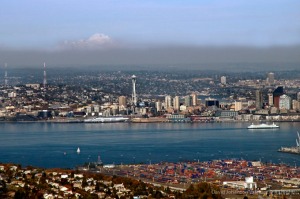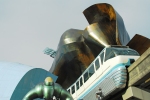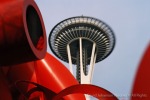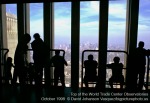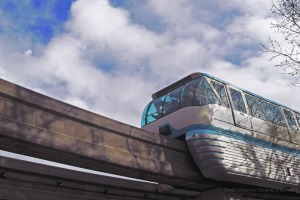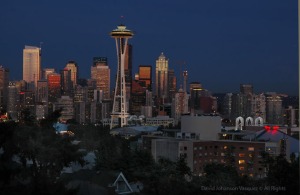ScienceTechTablet provides periodic updates on solar activity . The essay begins below the lead photo .
Prepared jointly by the U.S. Dept. of Commerce, NOAA,
Space Weather Prediction Center and the U.S. Air Force.
Updated 2013 Jul 19 2200 UTC
Joint USAF/NOAA Solar Geophysical Activity Report and Forecast
SDF Number 200 Issued at 2200Z on 19 Jul 2013
IA. Analysis of Solar Active Regions and Activity from 18/2100Z to
19/2100Z: Solar activity has been at very low levels for the past 24
hours. There are currently 7 numbered sunspot regions on the disk.
IB. Solar Activity Forecast: Solar activity is likely to be low with a
slight chance for an M-class flare on days one, two, and three (20 Jul,
21 Jul, 22 Jul).
IIA. Geophysical Activity Summary 18/2100Z to 19/2100Z: The geomagnetic
field has been at quiet to unsettled levels for the past 24 hours. Solar
wind speed, as measured by the ACE spacecraft, reached a peak speed of
674 km/s at 19/1650Z. Total IMF reached 12 nT at 18/2100Z. The maximum
southward component of Bz reached -9 nT at 19/0122Z. Electrons greater
than 2 MeV at geosynchronous orbit reached a peak level of 2710 pfu.
IIB. Geophysical Activity Forecast: The geomagnetic field is expected
to be at unsettled to minor storm levels on day one (20 Jul), unsettled
to active levels on day two (21 Jul) and quiet to unsettled levels on
day three (22 Jul).
III. Event probabilities 20 Jul-22 Jul
Class M 15/15/15
Class X 01/01/01
Proton 01/01/01
PCAF green
IV. Penticton 10.7 cm Flux
Observed 19 Jul 114
Predicted 20 Jul-22 Jul 115/115/115
90 Day Mean 19 Jul 121
V. Geomagnetic A Indices
Observed Afr/Ap 18 Jul 016/015
Estimated Afr/Ap 19 Jul 011/014
Predicted Afr/Ap 20 Jul-22 Jul 014/020-011/015-008/010
VI. Geomagnetic Activity Probabilities 20 Jul-22 Jul
A. Middle Latitudes
Active 35/30/25
Minor Storm 20/10/05
Major-severe storm 05/01/01
B. High Latitudes
Active 10/15/15
Minor Storm 25/30/30
Major-severe storm 50/40/30

Multimedia essay & images by: David Johanson Vasquez © All Rights Reserved
Part 1 & 2 of the series
To fully appreciate this story you’re encouraged to view two earlier multimedia essays on solar storms at: There’s nothing new under the Sun « Science Tech Tablet Will the current solar storms hitting Earth, lead to lights-out for us all by 2013? « Science Tech Tablet As a likely threat to ending our modern global civilization — a severe solar storm is unmatched as a natural disaster and yet it’s vastly underreported. An alternative graphic format of this essay is at: www.BigPictureOne.wordpress.com
Now that we’ve moved beyond December 21, 2012 and you know, the Mayan prophecy wasn’t about the end of the world, there’s some truly sobering news about what really does threaten our civilization. A powerful, natural solar event, which affects everyone living today, is now reaching the peak of a violent cycle. Documented by history and science, this event threatens our civilization by destroying the essential technology we rely on and throwing us all back into the “dark ages.” The key to avoiding this global catastrophe is within our grasp — if we and our National leaders are prepared to be aware of the problem and act by using the correct resources for defending our National power grid.
A Shocking Glimpse of Things To Come… 
To understand what we’re up against, you only have to go back a short distance of time, to March 13, 1989. A chain-reaction near the surface of the sun was triggered by a solar flare on March 9. Thousands of miles of magnetic arcs collided, causing violent high-energy explosions, which were instantly hurled into space. A plasma cloud from the event was observed heading directly towards earth at a million-miles per hour. As the sun’s radiation particle penetrated the Earth’s atmosphere, short-wave radio signals became disrupted, indicating our planet’s protective magnetic field was being overwhelmed. And the brilliant, surreal light-shows from the“northern lights” heralded the solar storm to astonished viewers in Florida and even Cuba.
A cascading wave of technical glitches, involving electronic components suddenly occurred globally and beyond! The monitoring systems on the U.S. Space Shuttle were sending corrupt signals to mission controllers, while a host of satellites began malfunction and a Japanese satellite was damaged beyond repair.
At 2:44 a.m., after only 90 seconds of detection, the massive Hydro-Quebec power company was knocked offline by surging geomagnetic energy caused from the aggressive solar storm. Moments later, hundreds of utilities within the Eastern U.S. were suddenly blacking out. As a result of the blackout six-million people were now without power on a winter’s day. Within 40 minutes of the geomagnetic current’s detection — the force continued to build like a Tsunami as it surged through the entire continental U.S. power grid, nearly collapsing all the Nation’s electric utilities in its path. The event’s speed and power led some to believe we were under attack from a Soviet nuclear electromagnetic pulse “EMP.”

Particle energy shock wave From solar storm is mostly deflected by Earth’s magnetic poles


The Achilles Heel of Our Technology.
Teams of scientist, engineers and physicist began piecing the 1989 events together and realized it was first, large scale, solar geomagnetic storm to hit during the postmodern digital electronic era. As powerful as the solar storm was in creating a rogue like wave of, geomagnetic induced current (GIC), which saturated the entire planet — it was only one-tenth the strength of the earlier 1921 “super solar storm.” Our electric infrastructure back in the 1920s was in its infancy and we didn’t have voltage sensitive microelectronics, which we now depend on to facilitate all our electronic devices. Today’s complex and overstretched power grids, with their high-power transmission lines are susceptible to geomagnetic energy created from solar storms.
The 1921 solar storm was what scientist classify as a one-in-hundred year storm. Many scientist from NOAA, NASA and the National Academy of Scientist (NAS) predicts a 10 to 12 percent probability of a super solar storm happening within the next 15 years and 100 percent likely beyond the referenced time period.
The 2013 solar cycle is now entering its 11-year, peak phase known as solar maximum, this critical phase is of a grave concern as the sun begins to reverse polarity and creates the potential for a super solar storms. History reveals over centuries, a consistent pattern in the approximate 11 year solar cycle… put the pattern together and it may reveal how little time we have to prepare. Here’s a sample pattern from three of the largest storms in recent history: 1989 Hydro-Quebec geomagnetic storm, the 1921 super solar storm event arrived and the greatest of them all — the 1859 Carrington Solar Storm event all taking place within the 11-year solar maxim.
Satellites, The Holly Grail of Telecommunications.

Photo courtesy of NASA
Solar storms and geomagnetic energy presents a spectrum of threats to satellite operations. Scientist, physicists and aerospace engineers have realized the challenges solar storms present to satellites since they were first launched into orbit. The geomagnetic energy caused from mass solar energy interacting with the Earths magnetic field, can cause satellites to lose their orientation and if not corrected… can end their lives or even send them hurling towards Earth . Geomagnetic energy is similar to the static electrify you create when walking on a carpet and then is discharge by touching a grounded object. In satellites there’s no way to discharge the electricity, so it will continue to buildup energy and can fry the tightly packed circuits or damage one of the orientation gyros within it. Another problem created from a GIC is the magnetic energy it contains, which can erase the memory in your computer or any memory storage device. The list of essential industries and services that are threatened by CIGs, goes well beyond the banking and financial industries.
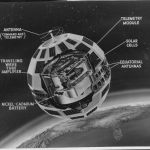
Telstar 1 Developed by Bell Labs and a consortium of international enterprises
Even though this subject is well know in the satellite industry, it’s not a topic journalists will have much luck in finding someone to go on the record for in interviews. Satellite companies don’t like admitting the reasons for technical problems experienced with their products. The military is even less forthcoming with satellite information. It’s understandable why the armed services maintains a proprietary stance on its satellites, but commercial satellite companies could benefit themselves and the entire industry by sharing their experiences with solar storm related activity.
If you have cable television, you’ve probably noticed at some time, the satellite transmitting your program being disrupted by solar storm radiation. An indicator for solar interference is digital tiling, which momentarily appears like a frozen video frame, before breaking up into smaller digital tiles. The last few times I’ve noticed digital tiling on my television, I verified it was from solar interference by going to NOAA’s space weather site, which in fact, confirmed elevated solar storm activity was happening.
Was It My Question On Satellite Solar Vulnerability, Which Brought An Abrupt End To An Interview With U.S. Senator Maria Cantwell?

Senator Maria Cantwell sharing her views on technology and education. Photo by: David Johanson Vasquez © All Rights Reserved.
This past July, I arranged a phone interview with Washington State, Senator Maria Cantwell. Senator Cantwell serves on the U.S. Senate committee for Commerce, Science and Transportation, satellites are a topic this committee holds hearings on. Cantwell is also the committee Chairman on Energy, for the Senate’s Energy and Natural Resources committee, which deals directly with the Nation’s electric grid.
The interview began with Senator Cantwell and her advisor as they were traveling to an event. After I gave a brief intro to the interview topics, Cantwell was asked to share what updates the Senate had on hardening our satellite against solar storms — particularly in respect to the aging GPS satellites, which are now being replaced. There was silence for a moment, it sounded like the Senator and her advisor had covered the phone for a discussion. Senator Cantwell said she would like to get back to me on that subject — I sensed in that moment, the satellite topic should have been brought up last, so I quickly changed gears and followed-up with — why the Senate was taking so long in approving a Bill that would help protect the National electric grid? Again, I didn’t get a direct answer and the Senator asked if we could finish the interview at another time.
Our latest technology in the transmission of electric power uses GPS satellites to help regulate the flow of high voltage electricity through power lines. Also used in the control and monitoring of the electric power is shortwave radio and phone lines all of which can be seriously interrupted by severe GIC caused from a solar storm.
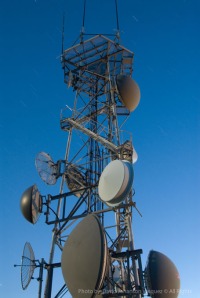
A spectrum of telecommunication may be lost during severe solar and geomagnetic storms. Photo: David Johanson Vasquez © All Rights
As it turned out, the Senate later that month approved 84-11 to move forward with advancing the proposal for Cybersecurity Act of 2012, which includes protecting the electric grid. As an example of taking one step forward and then taking two steps back — the Senate voted down in August and again in November the Cybersecurity Act. Part of the reason for the Bill not being approved is because of a legislative tactic, which attached unrelated or conflicting objectives to the Bill, so that opposing side feels they can get more out of the negotiations. It’s seems startling in this era of politics, when the Congress or Senate is able to come together and quickly pass any new law without using this protracted tactic.

It has to be noted, this was a phone interview, it wasn’t face to face, it’s possible a more pressing matter came in while the interview was in progress. Also, the Senator was in the final months of her Senate election campaign and probably was advised not to comment on anything, which could be perceived as politically damaging.
The interview illustrates how challenging it is to help inform the public, along with government officials on what we all are facing from an impending 100-year solar storm event. I have contacts within the electric power industry, including the Bonneville Power Administration, which have been helpful in providing their own perspective on geomagnetic storms, but they’ve all asked to speak off the record. Unfortunately there’s too much pressure to play down the GIC issue from inside the power industry. It’s not pleasant realizing how poorly prepared we are for a potential natural disaster on this scale — that’s why I believe, “mainstream corporate media” has neglected informing on the consequences solar storms can have on society. In reality, there are precautions which can be used to help protect the grid and society — but it requires courageous political leadership, which is almost as big as the problem its self.
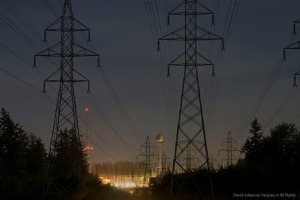
An Overstretched, Electric Power Grid Creates the Mother of All Antennas!
Government regulators, private and most public power companies have missed critical opportunities to invest in, strengthen and protect our electric power infrastructure from solar geomagnetic storms. Since the wake-up call of the 1989 Hydro-Quebec solar storm, our nation’s electrical grid has been overburden with higher demand and added thousands of high-voltage transmission lines. The vast network of power transmission lines stretching over the continent creates the mother of all antennas, by channeling geomagnetic energy into the electric grid. Like a lighting rod in a thunder-storm, the grid’s high-power transmission lines will channel the solar storms converted energy. The lack of investment and overuse of the grid makes it much more vulnerable than it ever was in 1989. An impending solar storm could produce the “perfect geomagnetic super storm,” which in a matter of minutes… decimates most of the nation’s ability to transmit power for several months or even years.
Recently there were comments in an open online physicist forum, regarding threats from geomagnetic storms to the National grid. One thread mentioned a possible way to stop a serious GIC event from destroying high-voltage transformers, would be to physically cut the power lines to the transformers. Another physicist replied that the plan just might work, however he wasn’t sure anyone would be willing an attempt to physically interrupt the electricity collecting behind a continent of power lines. 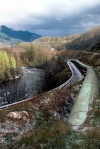
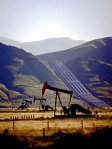
Underground pipelines and rail lines are also perfect conductors for channeling GIC’s electric current and have their own issues relating to damage from electro magnetic energy.

In the 1989 Hydro-Quebec geomagnetic storm, there were only 90 seconds to make a decision on what action to take. Most likely, power utilities today are more prepared with an action plan — however deciding to shut down any section of the grid is an extreme responsibility for an individual. To give an example, last November I was in Honolulu, Hawaii, meeting with a friend who works for the Core of Army Engineers. She mentioned, earlier in the year on the Island of Oahu, a serious problem occurred with the transmission of electricity. A plant operator realized something was critically wrong and made the decision to disconnect the power, which caused large sections of the Island to lose electricity. The initial response from the public and local media was anger and criticism towards the operator, for shutting down the power without notification to thousands of people. It turned out the utility operator actually saved the system from being severely damaged by deciding to act quickly. In this event if the power was allowed to remain on, it could have caused severe system damage and with repairs extremely expensive. So in reality the operator’s quick decision, and courageous action saved the day for thousands of customers.

Image courtesy of NASA
Deregulation of the Power Industry, Combined With No Centralized Authority over the National Grid In An Emergency — Potentially Jeopardizes the Economy and Our Safety.
Deregulation of the power industry has been an adopted policy since the 1980s. It was supposed to encourage industry competition, for creating greater profits for the utilities, allow for steady improvements of infrastructure and lower cost for consumers. In reality deregulation has failed to deliver on its stated objectives.
Independent and comprehensive cost/benefit studies were not completed before deregulation was adopted. Joseph Swidler, former chair of the Federal Power Commission, stated in 1990 editorial of The Electricity Journal — While there is bitter disagreement over … changes, there can be little argument these are occurring haphazardly without the benefit of comprehensive analyses at a national level.” A specific example is the absence of an analysis of the decrease in benefits from coordination as mentioned above, since competition typically results in decreased coordination. [A. Casazza, Allan J. Schultz and Joseph C. Swidler A brave new world: Let’s look before we leap The Electricity Journal, 1990, vol. 3, issue 9, pages 40-43] 
Engineering originally defined the qualifications and standards used for policy and management in the power industry. After deregulation regulated the industry, marketing and finance became the policy and management standard.

While the original standards used in the power industry were not perfect, it was more reliable and efficient than the current system — which has overstretched the National grid with higher capacity transmission lines and not sufficiently updated key infrastructure needs. Deregulation is what allowed for large-scale fraud and market manipulations to take place. This created unethical opportunities to gouge private consumers and large corporate customers by the former Enron Company in the early part of the 21st Century.
The Issue of High Voltage Transformers.
According to industrial insurer’s publications, deregulation has forced the majority of power utilities to survive on a slim profit margin, which does not provide adequate reinvestment for infrastructure or necessary research and development. Many of the high voltage transformers still functions today are at the edge of their life expectancy. It typically takes three years to order, install and have a transformer ready for service. High voltage transformers are no longer manufactured in the U.S.. On average, these industrial transformers weigh 100 to 200 tons and are too large to be sent by aircraft. Ironically these transformers require massive amounts of energy to manufacture.
A severe geomagnetic storm creates geomagnetic induced current (GIC), which transfers massive electric energy through the path of least resistance. This energy travels through water, earth and especially through metal such as underground pipes, rail line and electric power lines. The GIC saturates transformers, which distorts the voltage in the system and violently disrupts the entire process of transferring electric power.
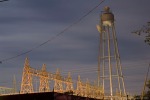
As a critical component in the distribution of electric power, transformers have proven vulnerable to geomagnetic energy and their survivability is a major concern to engineers and scientist. It’s likely a majority of the high voltage transformers would be at risk from the geomagnetic energy caused from a super solar storm. The transformers and the Nation’s electrical grid are more vulnerable on the East coast due to how overstretched the system is there. In the Western part of the U.S. the power utilities have been more proactive in protecting transformers and the grid is not as densely connected as it is in the East (at least in theory.) The further south in longitude a power grid’s location is a factor in lessening the effects of a geomagnetic storm. Also a location’s geology is a factor, some rock compositions conduct geomagnetic energy more efficiently than others.
According to leading engineering experts in the power industry, a practical strategy to protect the high voltage transformers is to install a surge protector like component on each transformer. The devices are about the size of a washer machine and would cost from $ 500 million to $ 1 billion dollars for the entire coverage. That’s probably the best value of an insurance policy which would cover the Nation’s electrical grid, especially compared to the alternative of replacing several hundred industrial size transformers.
http://www.lloyds.com/~/media/lloyds/reports/emerging%20risk%20reports/solar%20storm%20risk%20to%20the%20north%20american%20electric%20grid.pdf
A Comprehensive Study, With Extensive Geomagnetic Storm Computer Modeling.
In 2010, The Oak Ridge National Laboratory produced an extensive report titled: Geomagnetic Storms and Their Impact on the U.S. Power Grid. The Metatech Corporation was contracted to produce extensive computer modeling on various solar and geomagnetic storm scenarios. The report has been presented to both the U.S. Senate and House Congressional subcommittee hearings. Here’s a link to see for yourself how severe and extensive solar storm impact is likely to be using computer modeling.
http://www.ornl.gov/sci/ees/etsd/pes/pubs/ferc_Meta-R-319.pdf
The Prospect of 400 Chernobyl’s
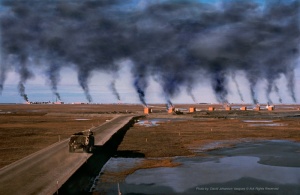
.
Russia’s Chernobyl and the United States’ Three Mile Island, are considered two of the greatest nuclear power plant disasters in history. Their legacy was clouds of lethal radiation, which caused mass evacuations and contaminated areas still not safe for people to inhabit. When these nuclear accidents occurred, there were no earthquakes, hurricanes or tornadoes to blame. The cause was a combination of technological failure and human error, which prevented the reactor’s cooling system to function, ultimately causing the nuclear disasters.
On March 11, 2011 the nuclear power plant in Fukushima, Japan experienced a violent 9.0 earthquake, followed by a massive tsunami. This time it was a natural disaster which caused a failure of the reactor’s cooling system. The backup electric generators to the reactor’s cooling system also unexpectedly failed, causing the reactors to begin overheating. The reactor released a substantial radioactive cloud, which forced a 20 mile radius evacuation.
There are federal disaster relief agencies, scientists and engineers questioning if a super geomagnetic storm would burn out the backup generators for cooling a nuclear power plant’s reactor. Another question is, will the trucks used for hauling diesel to backup generators, even work after waves of geomagnetic energy travel through a vehicles microelectronics. Any type of car transportation or truck transport will be extremely limited, if electricity is not generated to pumping gasoline and diesel from service stations.
In Hurricane Sandy and Katrina, a number of hospital’s critical backup generators failed to operate. It’s uncertain if backup generators will survive a severe geomagnetic disturbance from a solar storm. With over 400 nuclear power plants throughout the world, a serious geomagnetic storm, could potentially lead to loss of all electrical power to reactor core cooling systems, which would release radiation contamination on a global scale.
The Tragic Events of the RMS Titanic Serves As A Cautionary Analogy

This past April marked the 100 year anniversary of the “unsinkable” Titanic ocean liner’s maiden voyage. The once modern looking, massive ship was state of the art technology in 1912 — today it represents human arrogance and hubris towards over reliance on technology. The captain of the Titanic, Edward J. Smith, was quoted, of ‘not conceiving any disaster which could happen to his vessel’ — after all, no major passenger ship had been lost for nearly 50 years before the launch of the Titanic.

882 feet (269. meters) long maximum breath 92 feet (28. meters) 46, 328 gross registered tons.
White Star Line of Liverpool, England was the premier shipping company at the beginning of the 20th Century. White Star commissioned the construction of RMS Titanic – an Olympic class steam liner. The passenger ship was outfitted with twin colossal, coal-fired reciprocating turbine steam engines, and the ship’s electric generator produces more power than an average city’s power-plants at that time. It also featured the latest wireless communication technology, capable of sending and receiving signals 1,000 miles away. Owned and operated by the Marconi Company, the radio room was operated 24/7 using two technicians. The radio’s functions were primarily for commercial passenger telegram services, but it also served an operations function for the Titanic as it received useful weather reports and ice warnings.
A functional, forced air heating system used electric fans to push warm air through a ventilation network. The Titanic could in an emergency, produce its own fresh water from seawater using a desalination process. Many new living improvements and conveniences on this marvelous, “floating city” employed advance technology created during the late industrial era.

RMS Titanic in its final stages of construction is being outfitted before sea-trials.
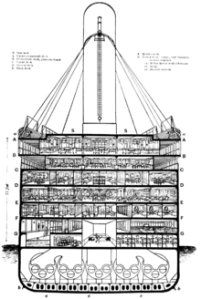
Full Speed Ahead Into the Night and Unseen Ice Fields
On April 14, 1912, three days into its maiden voyage the Titanic with its 1,317 passengers and 885 crew members moved swiftly across the North Atlantic. The ship averaged an efficient, 21 knots per hour (24 mph; 39 km/h) through the icy cold waters and was less than 1000 miles from its New York destination. As the streamliner approached the coast of Newfoundland, the skies were clearing over an unusually calm Atlantic Ocean. Throughout the day, Titanic’s radio operators received warnings from various ships in the route ahead of where they would soon enter — the captain responded by charting a 10 mile precautionary adjustment to the south for the ships heading. Throughout the day, warnings in Morse code reached Titanic’s radio operators in increase numbers and with more alarming urgency. The Captain assured the concerned operators — their ship had nothing to fear from icebergs and they should attend to the passengers’ important communication needs. As the late afternoon melted into –, Titanic was cruising at full-steam ahead and virtually blind in the calm featureless night.

Comparison of Morse Code.
Two ship’s lookouts climbed the long later attached inside the steamship’s smoke stack to reach the crow’s nest for the last time. Unfortunately, the bridge’s binoculars were missing, so the men were forced to rely on their plain eyesight to see any impending danger. The Titanic cruised effortlessly through the flat calm ocean, creating a false sense of security to the crew and passengers — but with icebergs in the water, on a moonless night meant no splashing waves to help warn a watchful lookout. Just before midnight, Fred Fleet, the lookout in the crow’s nest spotted the Titanic’ s dreadful rendezvous with destiny — a massive iceberg looming dead ahead. The bridge responded immediately by skillfully turning the ship away from the iceberg, the quick maneuver nearly was successful — but then… a horrible sound of solid ice scraping against sheets of steel plates and the profound, deep shutter delivered to the ship — telegraphed the Titanic was mortally wounded. Five watertight compartments were breached just below the waterline by the jagged ice, if just one-less compartment would have torn open, this story wouldn’t be told. The largest ship in the world, this floating world with its community of families, workers and wealthy aristocrats, now had less than three hours before the unthinkable end would happen.

The Captain and the Star Line management on board must have fallen into total shock and denial of what was happening to their Titanic, technological wonder. These individuals in charge with the responsibility for the ship’s operations and ultimately the passengers safety, were steeped in overconfidence, as they never conducted drills or consider necessary emergency contingencies and procedures. Fortified with hubris that the Titanic could withstand any act of nature, they lost sight of their most important duties of safe operations and procedures — after all, they believed in the myth their ship was built to be unsinkable.
In the same way the Titanic’s symbolizes a mythic system of indestructible technology, which can withstand anything nature can throw at — our civilization and specifically our Nation is repeating some of the basic errors regarding — an over reliance, complacency, and trust in life supporting technologies. We’ve been so fortunate to have built a civilization, which harnessed electrical technology to run our industry, heat our homes and provide our security. For decades, with few exceptions, we’ve had uninterrupted, reliable electric power that is now, taken for granted. Most of us have become shortsighted, with blind-faith in assuming we’ll have reliable electric power, whenever or wherever we need it.
Recorded history has demonstrated solar storms are a real threat to our technologies and civilization. Solar cycles,flares and storm events are a regular occurrence — a super geomagnetic storm will happen again, creating potential for catastrophic effects beyond any scale humanity has ever faced. Reliable, national and international scientific institutions and governmental agencies in charge of safety and security, increasingly warn us of these real threats to the electric grid.
Unlike RMS Titanic’s captain, whose hubris and over reliance on the technological engineering of his steam liner, lead to the tragic loss of his passengers and the world’s largest ship — our elected officials and top power industry executives, need awareness of our technology’s fatal weakness and decisively act now to defend it! If our Nation, like the Titanic waits until the impending disaster is upon us to act… It will be too late — the majority of our population, like those on the doomed infamous ship a 100-years ago will be scrambling for lifeboats that aren’t there. The millions of lives depending on electricity to transport food, medicine and provide security will have no safety-net for years to come. The threat from a natural continental or global catastrophic event is a known reality. It’s time for everyone to educate themselves and have an open dialogue with their families and communities regarding what precautions are necessary to minimize their effects. ~

Particle energy shock wave From solar storm is mostly deflected by Earth’s magnetic poles

A most beautiful video time-lapse of the Aurora Borealis – click → http://vimeo.com/11407018
Government Agencies Which Are Warning Of Solar Storm Potential Dangers
Severe Solar Storms Could Disrupt Earth This Decade: NOAA
Scientists warn solar storms could be “global Hurricane Katrina” | Homeland Security News Wire
Testimony Given to the U.S. Congress Regarding Threats to the National Grid from Solar Storms
Testimony Given to the U.S. Senate Regarding Threats to the National Grid From Solar Storms
Who Is In the Lead For the Darwin Award Between the U.S. Senate or Congress
Here are some links for your review to inform your own decision on who deserves the Darwin Award.
Feds and Utilities battle over Solar EMP threat in 2014 | SpaceBattles.com
Senators debate security of electricity grid – Washington Times
Senate dumps strategy to prevent EMP damage | The Total Collapse
Murkowski Blocks Effort to Protect US Power Grid
What Can We As Citizens Do To Protect the National Grid

.
.
.
Please check back to view the complete story — new content is being added daily, including an interview with Washington State Senator Maria Cantwell and comments from government agencies and electric power grid representatives.
.
Solar Storm & Electrical Power Portal [Editorial Links Government Links Industry links & Resources]
Solar Storms & Solar Weather
Space: NOAA Watch: NOAA’s All-Hazard Monitor: National Oceanic and Atmospheric Administration: U.S. Department of Commerce
NOAA / NWS Space Weather Prediction Center
Solar Storm Warning – NASA Science
SpaceWeather.com — News and information about meteor showers, solar flares, auroras, and near-Earth asteroids
Active Solar Regions – HAMwaves.com
Solar Satellites Research
Solar Shield–Protecting the North American Power Grid – NASA Science
Electric Power Industry Related to Solar Storm Issues
Disputes Dog Efforts to Protect Transmission Grid From ‘High-Impact, Low-Probability’ Threats – NYTimes.comEmergency Preparedness & Societal Concerns Related to Solar Storms & EMPs
Coming solar storm not likely to affect power grid – Technology & Science – CBC News
Are We Smart Enough to Survive … Or Will Humanity Win a Darwin Award? – Washington’s Blog
Editorial Articles, Media, Blog – Links &
Not Ready for a ‘Solar Sandy’ – NYTimes.com
Guarding Against Solar Storms – NYTimes.com
Impacts of Severe Space Weather on the Electric Grid by the MITRE Corporation, 11-2011.
Lawrence E. Joseph: The Solar ‘Katrina’ Storm That Could Take Our Power Grid Out For Years
Scientist Concern, Massive solar flare storm may occur before warning system is complete | The Guardian Express
Solar storm sparks dazzling northern lights | World news | The Guardian
Solar Storm’s Auroras May Dance Above Mid-U.S. This Weekend | Wired Science | Wired.com
Solar storm incoming: Federal agencies provide inconsistent, confusing information – Capital Weather Gang – The Washington Post
Tags: 1989 Hydro Quebec solar storm, 1989 Quebec Power blackout, 2013 Solar Maximum, 400 Chernobyl's, backup generator failure in solar storms, Congressional efforts to protect electric grid from solar storms, Darwin award winners, David Johanson multimedia specialist, David Johanson Vasquez, David Johanson Vasquez interview with Senator Maria Cantwell, Electric Power Industry deregulation, electrical grid, End of the world December 2012, FEMA, FERC, high power transformers, high voltage transformer shortage, Mayan prophecy, NASA, national grid, NERC, NOAA, overstretched electric grid, Power industry deregulation, risk management, RMS Titanic analogy to threats from solar storms, Satellite vulnerability to solar storms, Senate vote on Cybersecurity Act of 2012, Senator Cantwell interview on solar storms, Senator Maria Cantwell, smart grid, Solar cycle 24, Solar Flare, solar scientist, Solar shield satellite, solar storm damage to power grids, solar storm mitigation, solar storm portal, solar storm testimony to U.S Senate, solar storm testimony to U.S. House, solar storms, Solar weather portal, technology arrogance, technology hubris, the mother of all antennas, threat to civilization, threat to power grid, Turn the Lights Back On?, Will the Last People Remaining In America, WPLongposts





















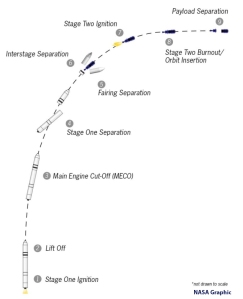





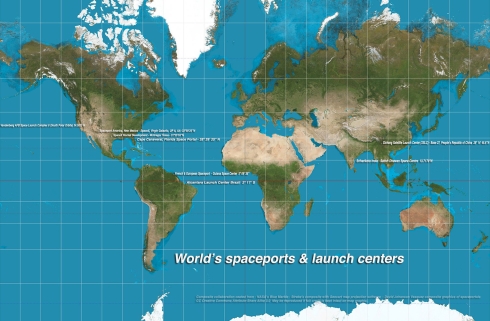



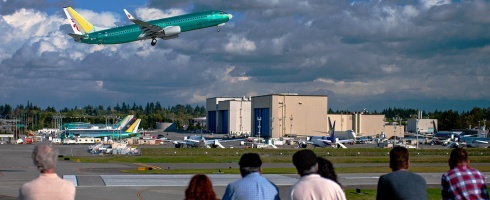










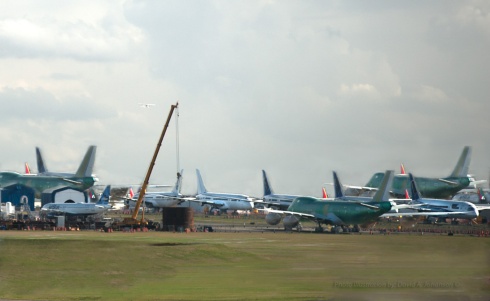










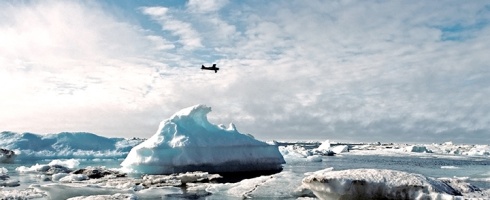
























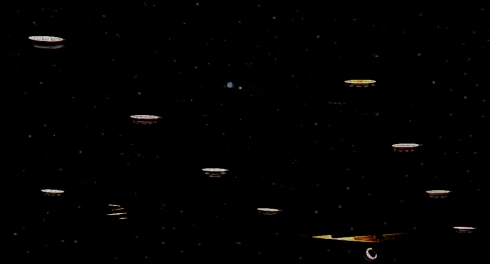
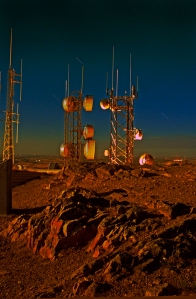









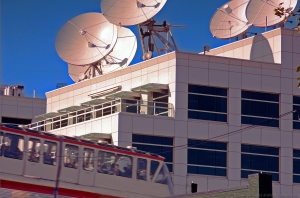














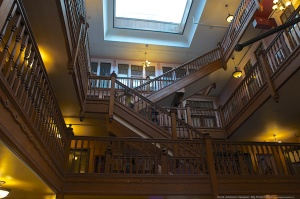





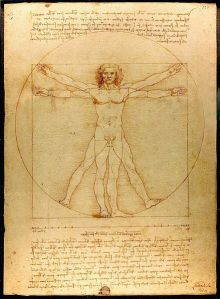
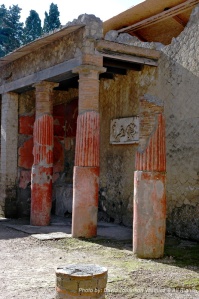

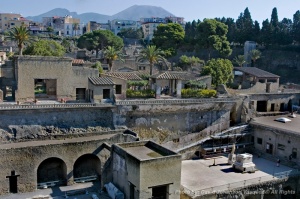









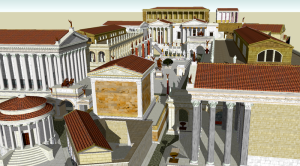








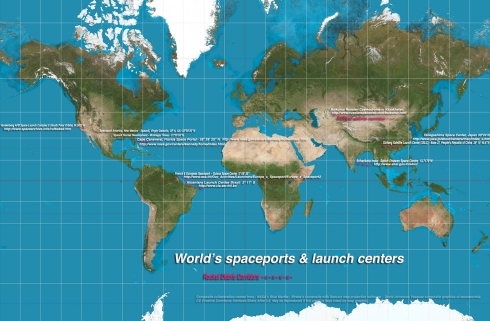


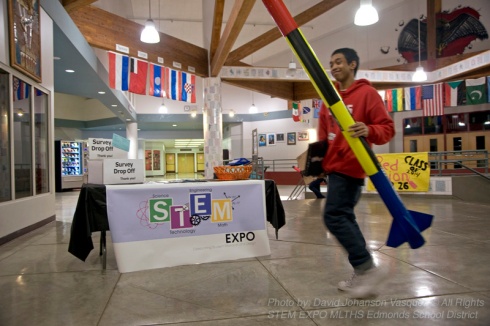
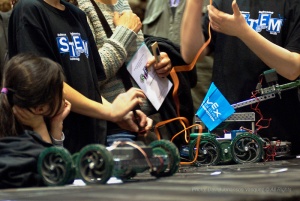
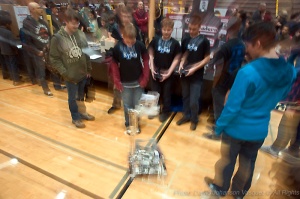




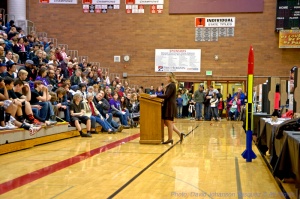
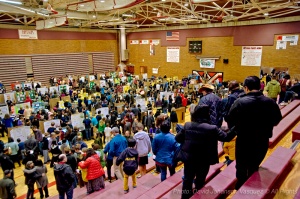
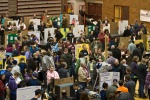
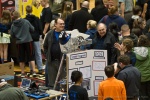




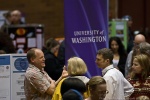
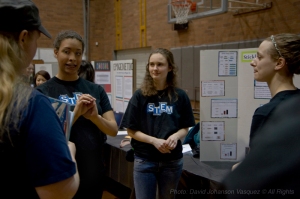



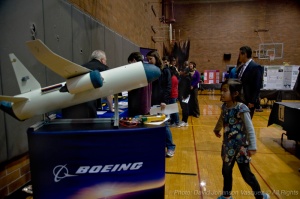
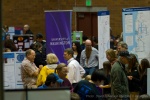
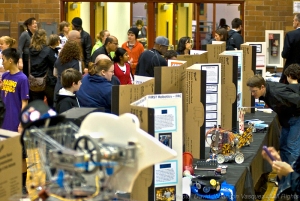

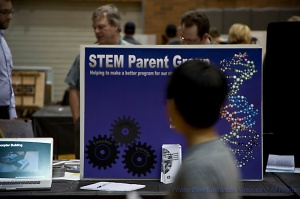

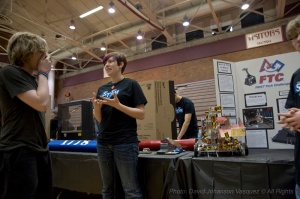
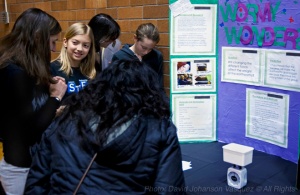
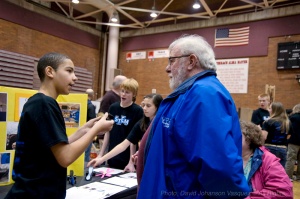


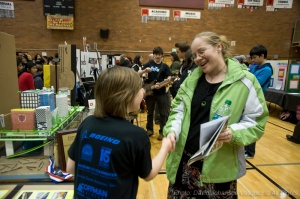

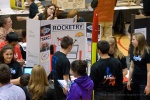



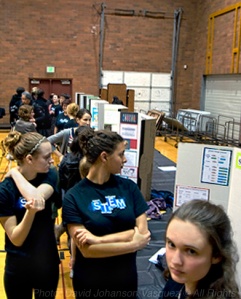








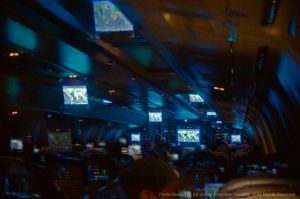




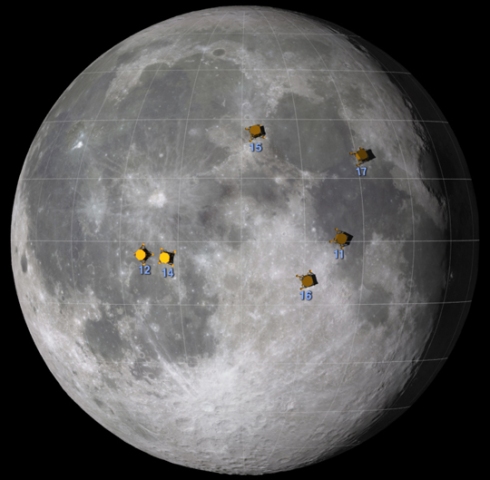
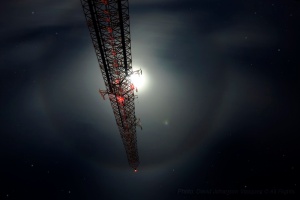
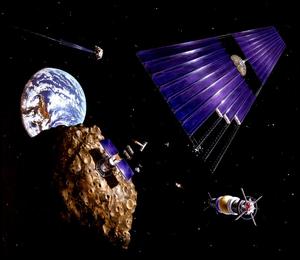
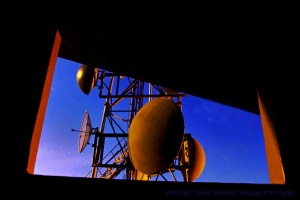













































 Radio astronomy’s powerful space exploratory telescope, was developed through research conducted by Karl Jansky in 1931. During this decade, Bell lab’s George Paget Thomson was awarded the Nobel Prize in physics for his discovery of electron diffraction, which was a key factor for solid-state.
Radio astronomy’s powerful space exploratory telescope, was developed through research conducted by Karl Jansky in 1931. During this decade, Bell lab’s George Paget Thomson was awarded the Nobel Prize in physics for his discovery of electron diffraction, which was a key factor for solid-state.


